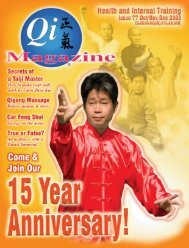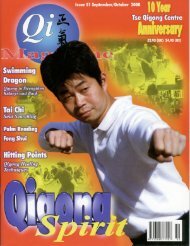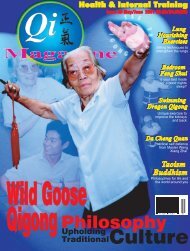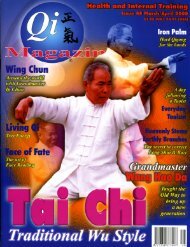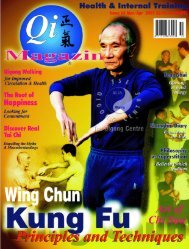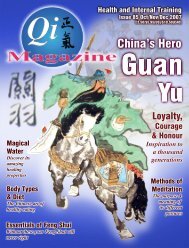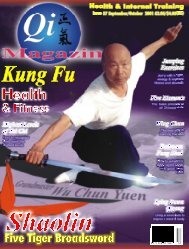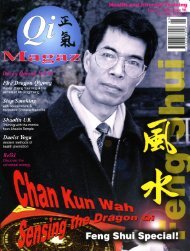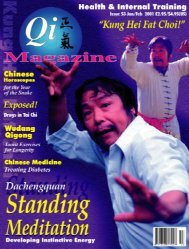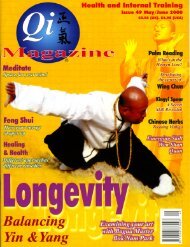You also want an ePaper? Increase the reach of your titles
YUMPU automatically turns print PDFs into web optimized ePapers that Google loves.
Shaolin Taiji<br />
For some time a debate has been raging over the actual origins of Taijiquan. Some say it<br />
was Chen Wanting who created the skill whilst others argue it was the Daoist Zhang San Feng.<br />
However, now another contender has entered the fray, read on to discover more...<br />
oday nobody can deny that<br />
amongst all the five styles of<br />
Taijiquan, Chen, Yang, Wu, Sun<br />
and Woo, Yang style is the most<br />
popular throughout the world.<br />
Recently, much research has been done<br />
into the history and roots of Taijiquan and<br />
researchers have used the old registry of<br />
Chen Village (Wen County, Henan<br />
Province) to conclude that Chen style is<br />
the oldest and it is from this that the Yang,<br />
Wu, Sun, and Woo styles evolved. To this<br />
point there is no contest raised because<br />
the old<br />
registry holds<br />
the earliest<br />
w r i t t e n<br />
records on<br />
Ta i j i q u a n<br />
which date<br />
back to<br />
1600AD, the<br />
period in<br />
which Chen<br />
Wang Ting<br />
lived. No<br />
doubt his<br />
f o l l o w e r s<br />
would have hailed him as the founder or<br />
the first person to begin practising the<br />
slow – fast, soft – hard format of training<br />
which was later to become known as<br />
Taijiquan.<br />
Although there are no written<br />
records, only those that have been passed<br />
down orally, some Chen villagers believe<br />
that a man named Chen Bu, who lived<br />
around 1374AD, was the first Chen<br />
clansman to have practised similar martial<br />
arts. If this theory can be proved then<br />
there is no doubt that Chen Style<br />
Taijiquan is the oldest form of Taijiquan<br />
being practised today. Being a follower of<br />
Chen Taijiquan since 1985, I was<br />
convinced that the results of these fact<br />
finding missions must be true. That was<br />
until I came across<br />
s o m e t h i n g<br />
disturbing in the<br />
library of the<br />
Songshan Shaolin<br />
Temple.<br />
During one of<br />
my training/research trips<br />
back to the Shaolin Temple<br />
I believe I witnessed the<br />
father of all Taijiquan<br />
and it has taken me<br />
some years to conclude<br />
my own research<br />
I witnessed one of the<br />
older monks practising a<br />
slow hand set that was<br />
completely different<br />
from all other Shaolin<br />
forms that I had seen.<br />
The slow – fast, soft –<br />
hard approach of the<br />
movements was<br />
intriguing and aroused<br />
my curiosity. As a<br />
practitioner of Chen<br />
Taiji I saw a similar frame<br />
work. The stamping of<br />
the foot, the ‘shock’ explosive techniques<br />
delivered could easily be mistaken as one<br />
of the Chen forms. I thought I<br />
was in Chenjiagou<br />
(Chen<br />
Village), but it<br />
struck me that I<br />
was still standing<br />
inside the Songshan<br />
Shaolin Temple.<br />
Afterwards I was able<br />
to get the name of the form<br />
from the monk. The form was<br />
known inside the Temple as<br />
Shaolin Rouquan or Shaolin<br />
Soft Hands. However, the old<br />
monk declined to reveal any<br />
more information. Still curious<br />
to find out more, I quickly went<br />
to the Abbot , then the late Shi<br />
Dechan, seeking permission to<br />
look at some old Shaolin texts.<br />
I believe that I had<br />
witnessed the father of all Taijiquan<br />
and since this incident, it has taken<br />
me some years to conclude my own<br />
research. Obviously I was reluctant to<br />
Qi Magazine 28



